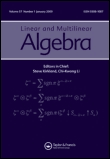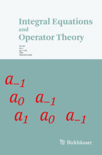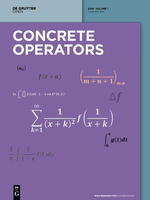
Journal of Spectral Theory
Scope & Guideline
Transforming Insights into Spectral Applications
Introduction
Aims and Scopes
- Spectral Analysis of Operators:
The journal emphasizes the study of spectral properties of various linear operators, including self-adjoint, non-self-adjoint, and differential operators. This includes the exploration of eigenvalues, eigenfunctions, and spectral measures. - Inequalities and Functional Calculus:
A significant area of focus involves the development and application of inequalities related to spectral theory, such as Hardy's inequalities and Lieb-Thirring inequalities, alongside functional calculus techniques for operators. - Quantum Mechanics Applications:
The journal often publishes papers that bridge spectral theory with quantum mechanics, exploring topics like quantum graphs, Dirac operators, and Schrödinger operators, highlighting their implications in physical systems. - Mathematical Methods and Asymptotics:
There is a consistent focus on asymptotic analysis, including spectral asymptotics and perturbation theory, which are crucial for understanding the behavior of eigenvalues in various limiting cases. - Topology and Geometry in Spectral Theory:
The interplay between spectral theory and geometric/topological aspects is a unique contribution, with studies on manifolds, graphs, and geometric properties influencing spectral characteristics.
Trending and Emerging
- Quantum Graphs and Topological Aspects:
Recent publications show a growing interest in quantum graphs and their spectral properties, highlighting the importance of topology in understanding eigenvalue distributions and bound states in quantum systems. - Asymptotic Analysis and Spectral Stability:
There is an increasing emphasis on asymptotic methods and spectral stability, particularly in relation to perturbed operators and their implications for quantum systems, indicating a trend towards understanding long-term behaviors. - Applications to Graphene and Advanced Materials:
The exploration of spectral properties related to materials like twisted bilayer graphene demonstrates an emerging interdisciplinary trend, connecting mathematical theory with physical applications in condensed matter physics. - Computational and Numerical Methods:
A noticeable trend towards computational approaches in spectral analysis is evident, with researchers increasingly addressing numerical methods and algorithms for spectral problems, reflecting a broader trend in applied mathematics. - Higher-Dimensional and Non-Self-Adjoint Operators:
Research involving higher-dimensional operators and non-self-adjoint problems is on the rise, indicating a shift towards addressing more complex and realistic models in spectral theory.
Declining or Waning
- Classical Spectral Theory:
There has been a noticeable decrease in papers addressing classical spectral theory concepts without modern applications. As the field evolves, researchers are gravitating towards more complex interactions and applications rather than foundational aspects. - Nonlinear Spectral Problems:
Research on nonlinear spectral problems appears to be less frequent in recent issues. This may indicate a shift towards linear frameworks, which are more tractable and applicable in current mathematical and physical contexts. - Lower-Dimensional Spectral Studies:
Papers focusing solely on one-dimensional spectral problems or lower-dimensional cases have become less common, as the journal's direction increasingly favors multidimensional and complex systems. - Purely Theoretical Constructs:
There seems to be a reduction in purely theoretical constructs without direct applications or implications, as the journal emphasizes results that connect more closely with practical or computational aspects.
Similar Journals

LINEAR & MULTILINEAR ALGEBRA
Advancing the Frontiers of Algebraic ResearchLINEAR & MULTILINEAR ALGEBRA, published by Taylor & Francis Ltd, is a distinguished academic journal that has been contributing to the field of mathematics since 1973. With an ISSN of 0308-1087 and an E-ISSN of 1563-5139, this journal focuses on innovative research in algebra and number theory, reinforcing its standing as a vital resource for mathematicians worldwide. Currently ranked in the Q2 quartile of its category, and holding an impressive rank of 13 out of 119 in Scopus, it occupies a prominent position in the field, commanding a significant 89th percentile. The journal aims to disseminate groundbreaking research, critical reviews, and theoretical advancements, making it an essential platform for both established researchers and emerging scholars. With a publishing horizon stretching to 2024, LINEAR & MULTILINEAR ALGEBRA is poised to continually influence the mathematical community while fostering a deeper understanding of linear and multilinear frameworks.

Banach Journal of Mathematical Analysis
Connecting Scholars through Innovative Mathematical ResearchWelcome to the Banach Journal of Mathematical Analysis, a distinguished publication under the auspices of SPRINGER BASEL AG, dedicated to the field of mathematical analysis and its applications. With a strong reputation reflected in its Q2 ranking within both Algebra and Number Theory as well as Analysis categories for 2023, this journal serves as a pivotal resource for researchers and professionals striving to advance their understanding and contributions to the mathematical sciences. As an esteemed platform featuring innovative research from around the globe, the journal promotes open discourse among practitioners of various mathematical disciplines. Although currently not an open access journal, it enhances visibility through rich content, consistently ranked with notable Scopus metrics, including impressive standings in both algebraic structures and analytic methods. Join a vibrant community of scholars who are shaping the future of mathematics by exploring the latest insights and methodologies published within these pages.

INTEGRAL EQUATIONS AND OPERATOR THEORY
Advancing the frontiers of algebra and analysis.INTEGRAL EQUATIONS AND OPERATOR THEORY, published by SPRINGER BASEL AG, stands at the forefront of research in the fields of algebra, number theory, and analysis, with an esteemed categorization of Q2 in both disciplines as of 2023. With its ISSN 0378-620X and E-ISSN 1420-8989, this journal not only maintains a rigorous standard for scholarly contributions but also offers a vital platform for discourse on theoretical and applied aspects of integral equations and operator theory. Established in 1978, it has nurtured academic growth and innovation, with contributions continuing up to 2024. The journal holds respectable Scopus rankings, placed 43rd out of 119 in Algebra and Number Theory, and 110th out of 193 in Analysis, establishing its relevance and impact within the mathematical community. Researchers, professionals, and students alike will find INTEGRAL EQUATIONS AND OPERATOR THEORY to be an invaluable resource for advancing knowledge, fostering collaboration, and inspiring future studies within these critical areas of mathematics.

JOURNAL OF OPERATOR THEORY
Elevating Understanding in Algebra and Number TheoryJOURNAL OF OPERATOR THEORY is a distinguished periodical published by the THETA FOUNDATION based in Romania. With a specific focus on the realms of mathematics, particularly in the areas of operator theory and its applications in algebra and number theory, this journal plays a crucial role in disseminating high-quality research that advances theoretical understanding and practical applications. It is indexed with an impressive rank of #58 out of 119 in the Scopus Mathematics category, placing it within the 51st percentile nationally. The journal has evolved significantly since its establishment, with publications spanning from 1996 through 2024, and maintaining a reputable stature in the Q2 quartile for Algebra and Number Theory as of 2023. While it operates under a subscription model, the JOURNAL OF OPERATOR THEORY remains an essential resource for researchers, professionals, and students seeking to engage deeply with contemporary mathematical issues and promote advancements in the field. For those looking to explore innovative findings and methodological approaches, this journal is indispensable.

Complex Analysis and Operator Theory
Unveiling Insights in Complex AnalysisComplex Analysis and Operator Theory, published by Springer Basel AG, is a renowned journal in the field of applied and computational mathematics, reflecting a strong engagement with contemporary mathematical challenges. With an ISSN of 1661-8254 and E-ISSN 1661-8262, this journal provides a platform for disseminating significant findings and innovative methodologies that contribute to the advancement of complex analysis, operator theory, and their diverse applications. As a valuable resource for researchers and practitioners alike, it features high-quality peer-reviewed articles that rigorously explore both theoretical and practical aspects of mathematics. Although it currently does not offer open access, readers can access its insightful content through institutional subscriptions or individual purchases. Since its inception in 2007, the journal has carved a niche for itself, evidenced by its placement in the Q2 quartiles in both Applied Mathematics and Computational Mathematics, and its recognition in Computational Theory and Mathematics. With an ambitious goal to foster the dialogue between theory and practice, Complex Analysis and Operator Theory continues to support the mathematical community from its base in Basel, Switzerland.

Concrete Operators
Advancing Mathematical Frontiers with Concrete InsightsConcrete Operators is an innovative academic journal published by DE GRUYTER POLAND SP Z O O, specializing in the fields of Analysis and Applied Mathematics. With an ISSN of 2299-3282, this open access journal has been dedicated to fostering scholarly communication since its inception in 2013. Concrete Operators aims to provide a platform for researchers, professionals, and students to explore and disseminate significant findings in mathematical analysis and its practical applications. Housed in Germany, with administrative offices located in Warsaw, Poland, the journal embraces a global audience. Notably, as of 2023, it holds a Q4 category ranking in the respective mathematical domains, reflecting its commitment to emerging research within the community. The journal's open access model enhances visibility and accessibility, encouraging collaboration and innovation among mathematicians. By bridging theoretical advances with practical implementations, Concrete Operators plays a vital role in the advancement of mathematical sciences.

Rendiconti del Circolo Matematico di Palermo
Navigating the Evolution of Mathematical Ideas.Rendiconti del Circolo Matematico di Palermo, published by SPRINGER-VERLAG ITALIA SRL, is a revered journal in the field of mathematics, emphasizing the cultivation and dissemination of mathematical knowledge since its inception in 1887. With its ISSN 0009-725X and E-ISSN 1973-4409, this esteemed publication has continued to thrive, showcasing innovative research, comprehensive reviews, and thoughtful discussions from diverse areas in mathematics, particularly in its Q2 ranking within the miscellaneous mathematics category. Its historical significance is underscored by its convergence of publications across numerous years, including its notable periods from 1887 to 1916, 1919 to 1938, and beyond, effectively capturing the evolution of mathematical thought. Though not open access, the journal remains an essential resource for researchers, professionals, and students aiming to stay updated with the latest advancements and methodologies in the ever-evolving landscape of mathematics. With its Scopus rank placing it in the top 25th percentile, Rendiconti del Circolo Matematico di Palermo continues to be a cornerstone for scholarly dialogue and development in its domain.

Pure and Applied Mathematics Quarterly
Shaping the Future of Mathematics with Every IssuePure and Applied Mathematics Quarterly is a prestigious journal published by INT PRESS BOSTON, INC, focusing on the diverse and evolving field of mathematics. Since its inception in 2007, this journal has grown significantly, currently holding a Q1 ranking in the Mathematics (Miscellaneous) category for 2023, positioning it among the leading publications in the discipline. With a commitment to publishing high-quality research, Pure and Applied Mathematics Quarterly fosters innovation and dialogue within the mathematical community by providing a platform for theoretical advancements and practical applications. The journal remains accessible to researchers and professionals through its ISSN 1558-8599 and E-ISSN 1558-8602, although it does not currently offer open access. As a vital resource for mathematicians, educators, and students, this journal endeavors to expand the frontiers of mathematical knowledge and contribute to the academic dialogue surrounding this fundamental science.

Journal of Mathematical Analysis
Empowering Researchers Through Open Access InsightsThe Journal of Mathematical Analysis, published by UNIV PRISHTINES in Serbia, offers a dedicated platform for the dissemination of innovative research in the fields of mathematical analysis and applied mathematics. With an ISSN of 2217-3412 and a convergence period from 2020 to 2024, this journal aims to foster significant advancements in both theoretical and practical aspects of mathematics. Categorized in the Q4 quartile for Analysis, Applied Mathematics, and miscellaneous Mathematics as of 2023, it serves as an essential resource for researchers and professionals alike, providing key insights into the evolving landscape of mathematical inquiry. Although it is an open access journal, facilitating global readership, its Scopus rankings reflect its emerging status, with rankings indicating a 51st percentile in Mathematics (miscellaneous) and 28th percentile in Applied Mathematics. This journal not only aims to contribute to academic discourse but also seeks to bridge gaps between mathematical theory and real-world applications, making it a vital resource for students and professionals engaged in the complexities of mathematical research.

Milan Journal of Mathematics
Elevating mathematics through rigorous scholarship.Milan Journal of Mathematics is a prestigious academic publication dedicated to advancing the field of mathematics, particularly in the miscellaneous areas of the discipline. Published by SPRINGER BASEL AG in Switzerland, this journal has established a strong impact in the academic community, noted for its Q1 ranking in Mathematics and achieving a commendable 80th percentile in the Scopus rankings. With an ISSN of 1424-9286 and E-ISSN 1424-9294, the journal serves as a crucial platform for researchers and scholars to disseminate their findings and engage with cutting-edge mathematical theories and applications. Although not an Open Access publication, it provides valuable insights and rigorous academic discourse for professionals, researchers, and students alike, fostering a rich environment for knowledge exchange and innovation in mathematics.